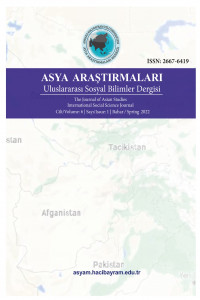Öz
The democratic transition in Mongolia took place in 1990 as a result of non-violence, peace, and mutual understanding in the social-political sphere. The study evaluates the democratic transition in Mongolia in terms of the relationship between strengthening democracy and consolidating state-building overviews. The paper puts forward the main argument that in the last three decades, the combination of strengthening democracy and consolidating state-building is vital based on transition practice in Mongolia. Thus, first, it is concerned with the term democracy meaning, its origin, and its theories. Second, it examines the transition and consolidation of democracy in Mongolia. Third, the paper offered a further development model for democracy and governance in Mongolia.
Anahtar Kelimeler
Democracy Democratic Transition Governance State-Building Mongolia
Kaynakça
- Asad, T. (2006). Trying to Understand French Secularism. In H. d. Sullivan, & H. d. Sullivan (Ed.), Political Theologies: Public Religions in a Post-Secular World (pp. 494-526). New York: Fordham University Press.
- Bayarkhuu, D. (2018). The Geopolitic and Foreign Policy of Mongolia. Ulaanbaatar: Munkhiin Useg Press.
- Binğöl, Y. (2004). Nationalism and Democracy in Post-Communist Central Asia. Kocaeli: Carfax.
- Bold, R. (2018). The geopolitical issues of Mongolia. Ulaanbaatar: National Academy of Governance Press.
- Byambasuren, D. (2017). Nadad 1990-eed ony ued uls ornyhoo tuluu hiisen alkhamuuddaa kharamsakh zuil baidaggui. Management Skill, 51. Constitution. (1992, 1 13). Constitution of Mongolia. Constitution of Mongolia. Ulaanbaatar, Mongolia: Parliament of Mongolia.
- Freedom House. (2020, 5 10). Freedom House. Retrieved from https://freedomhouse.org/: https://freedomhouse.org/explore-the-map?type=fiw&year=2020
- FPCM. (2011, 2 10). Foreign Policy Concept of Mongolia (FPCM). Ulaanbaatar, Mongolia: Parliament Press. Retrieved 10 30, 2018 Fraser. (2020, 5 11). Fraser Institution. Retrieved from https://www.fraserinstitute.org/: https://www.fraserinstitute.org/economic-freedom/map?geozone=world&page=map&year=2017&countries=MNG
- GECM. (2017). The General Election Commission of Mongolia (GECM)'s statistics on Parliament Elections in Mongolia 1992-2016. Ulaanbaatar: Admon Print.
- Heywood, A. (2017). Political Ideologies. London: Palgrave.
- Huntington, S. P. (1991). The Third wave: Democratization in the late twentieth century. London: Univeristy of Oklahoma Press.
- Jeffries, I. (2007). Mongolia: A guide to economic and political developments. New York: Routledge.
- Lattimore, O. (1956, 3). Satellite Politics: The Mongolian Prototype. The Western Political Quarterly, Vol. 9, No. 1 (Mar., 1956), pp. 36-43, 9(1), 36-43. Retrieved from https://www.jstor.org/stable/443249
- Lijphart, A. (2012). PATTERNS OF DEMOCRACY Government Forms and Performance in Thirty-Six Countries. New Haven and London: Yale University Press.
- MFA. (2018). Ministry of Foreign Affairs of Mongolia. Ulaanbaatar: Ministry of Foreign Affairs of Mongolia. Retrieved 12 5, 2019, from http://www.mfa.gov.mn/
- Norris, P. (2012). Making Democratic Governance Work. Cambridge: Cambridge University Press.
- Schmücking, D. (2015). Search for the third border: Mongolian foreign policy between Russia and China. Bonn: Konrad Adenauer Foundation.
- SCM. (2020, 5 10). Supreme Court of Mongolia. Retrieved from http://www.supremecourt.mn/: http://www.supremecourt.mn/nam
- Stepan, A. (2011). The Multiple Secularisms of Modern Democratic and Non-Democratic Regimes. In M. J. Craig Calhoun (Ed.), Rethinking Secularism (p. 121).
- Oxford and New York: Oxford University Press.
- Taylor, S. L. (2012). 30-SECOND POLITICS. London: Ivy Press Limited.
- Vietor, R. (2006). How Countries Compete: Strategy and Structure. Boston: Harvard University Press.
- World Bank. (2020, 5 11). Doing Business 2020. Retrieved 12 1, 2019, from http://www.doingbusiness.org: http://www.doingbusiness.org
- World Bank. (2020, 5 11). World Bank. Retrieved from https://www.worldbank.org: https://www.worldbank.org/en/country/mongolia/overview
Öz
Kaynakça
- Asad, T. (2006). Trying to Understand French Secularism. In H. d. Sullivan, & H. d. Sullivan (Ed.), Political Theologies: Public Religions in a Post-Secular World (pp. 494-526). New York: Fordham University Press.
- Bayarkhuu, D. (2018). The Geopolitic and Foreign Policy of Mongolia. Ulaanbaatar: Munkhiin Useg Press.
- Binğöl, Y. (2004). Nationalism and Democracy in Post-Communist Central Asia. Kocaeli: Carfax.
- Bold, R. (2018). The geopolitical issues of Mongolia. Ulaanbaatar: National Academy of Governance Press.
- Byambasuren, D. (2017). Nadad 1990-eed ony ued uls ornyhoo tuluu hiisen alkhamuuddaa kharamsakh zuil baidaggui. Management Skill, 51. Constitution. (1992, 1 13). Constitution of Mongolia. Constitution of Mongolia. Ulaanbaatar, Mongolia: Parliament of Mongolia.
- Freedom House. (2020, 5 10). Freedom House. Retrieved from https://freedomhouse.org/: https://freedomhouse.org/explore-the-map?type=fiw&year=2020
- FPCM. (2011, 2 10). Foreign Policy Concept of Mongolia (FPCM). Ulaanbaatar, Mongolia: Parliament Press. Retrieved 10 30, 2018 Fraser. (2020, 5 11). Fraser Institution. Retrieved from https://www.fraserinstitute.org/: https://www.fraserinstitute.org/economic-freedom/map?geozone=world&page=map&year=2017&countries=MNG
- GECM. (2017). The General Election Commission of Mongolia (GECM)'s statistics on Parliament Elections in Mongolia 1992-2016. Ulaanbaatar: Admon Print.
- Heywood, A. (2017). Political Ideologies. London: Palgrave.
- Huntington, S. P. (1991). The Third wave: Democratization in the late twentieth century. London: Univeristy of Oklahoma Press.
- Jeffries, I. (2007). Mongolia: A guide to economic and political developments. New York: Routledge.
- Lattimore, O. (1956, 3). Satellite Politics: The Mongolian Prototype. The Western Political Quarterly, Vol. 9, No. 1 (Mar., 1956), pp. 36-43, 9(1), 36-43. Retrieved from https://www.jstor.org/stable/443249
- Lijphart, A. (2012). PATTERNS OF DEMOCRACY Government Forms and Performance in Thirty-Six Countries. New Haven and London: Yale University Press.
- MFA. (2018). Ministry of Foreign Affairs of Mongolia. Ulaanbaatar: Ministry of Foreign Affairs of Mongolia. Retrieved 12 5, 2019, from http://www.mfa.gov.mn/
- Norris, P. (2012). Making Democratic Governance Work. Cambridge: Cambridge University Press.
- Schmücking, D. (2015). Search for the third border: Mongolian foreign policy between Russia and China. Bonn: Konrad Adenauer Foundation.
- SCM. (2020, 5 10). Supreme Court of Mongolia. Retrieved from http://www.supremecourt.mn/: http://www.supremecourt.mn/nam
- Stepan, A. (2011). The Multiple Secularisms of Modern Democratic and Non-Democratic Regimes. In M. J. Craig Calhoun (Ed.), Rethinking Secularism (p. 121).
- Oxford and New York: Oxford University Press.
- Taylor, S. L. (2012). 30-SECOND POLITICS. London: Ivy Press Limited.
- Vietor, R. (2006). How Countries Compete: Strategy and Structure. Boston: Harvard University Press.
- World Bank. (2020, 5 11). Doing Business 2020. Retrieved 12 1, 2019, from http://www.doingbusiness.org: http://www.doingbusiness.org
- World Bank. (2020, 5 11). World Bank. Retrieved from https://www.worldbank.org: https://www.worldbank.org/en/country/mongolia/overview
Ayrıntılar
| Birincil Dil | İngilizce |
|---|---|
| Bölüm | Makaleler |
| Yazarlar | |
| Yayımlanma Tarihi | 30 Haziran 2022 |
| Yayımlandığı Sayı | Yıl 2022 Cilt: 6 Sayı: 1 |


